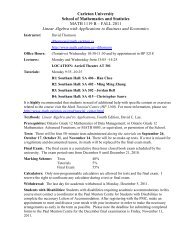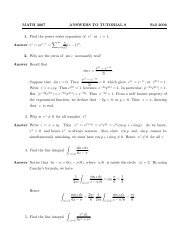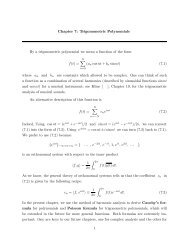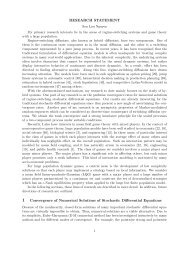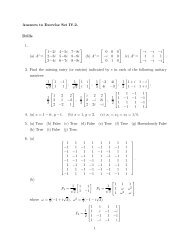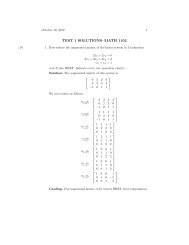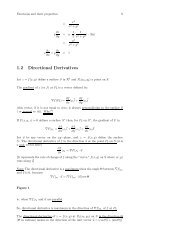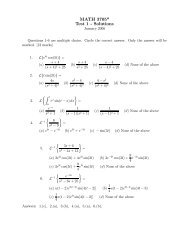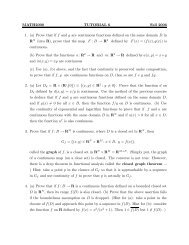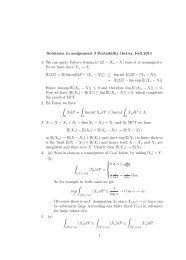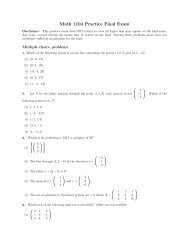CHAPTER II DIMENSION In the present chapter we investigate ...
CHAPTER II DIMENSION In the present chapter we investigate ...
CHAPTER II DIMENSION In the present chapter we investigate ...
You also want an ePaper? Increase the reach of your titles
YUMPU automatically turns print PDFs into web optimized ePapers that Google loves.
Chapter <strong>II</strong>I will be devoted to <strong>the</strong> basic skill of handling <strong>the</strong> summation symbol. You may<br />
return to <strong>the</strong> second proof after studying that section.<br />
Again let E and F be two bases in V , where E consists of vectors e1, e2, . . . , em and<br />
F consists of f1, f2, . . . , fn. Now each vector in E can be written as a linear combination<br />
of vectors in F and vice versa, say<br />
ej = n<br />
For each ℓ with 1 ≤ ℓ ≤ n, <strong>we</strong> have<br />
k= 1 pjkfk and fk = m<br />
j= 1 qkjej.<br />
fℓ = <br />
j qℓjej = <br />
j qℓj<br />
<br />
k pjkfk = <br />
j<br />
= <br />
k j qℓjpjkfk = <br />
k j qℓjpjk<br />
<br />
fk.<br />
k qℓjpjkfk<br />
Since f1, f2, . . . , fn form a basis, <strong>the</strong> coefficient of fk must be <strong>the</strong> same for each k, equal<br />
to 1 for k = ℓ and zero o<strong>the</strong>rwise. Thus <strong>we</strong> have<br />
<br />
j qℓjpjk<br />
<br />
1,<br />
= δℓk ≡<br />
0,<br />
if k = ℓ;<br />
o<strong>the</strong>rwise.<br />
(2.2.1)<br />
(Here, δℓk given above is <strong>the</strong> so-called Kronecker’s delta.) We can rewrite (2.2.1) in<br />
matrix form as QP = <strong>In</strong>, where <strong>In</strong> is <strong>the</strong> n × n identity matrix and<br />
⎡<br />
⎤ ⎡<br />
⎤<br />
p11 · · · · · · p1m<br />
q11 · · · · · · q1n<br />
⎢<br />
P =<br />
.<br />
⎣ .<br />
. ⎥ ⎢ .<br />
. ⎥<br />
.<br />
. ⎦ , Q = ⎣ .<br />
. ⎦ .<br />
pn1 · · · · · · pnm<br />
qm1 · · · · · · qmn<br />
By reversing <strong>the</strong> roles of p’s and q’s, <strong>we</strong> know that (2.2.1) holds if p and q are switched,<br />
giving us P Q = Im.<br />
♠ Aside: Merely P Q = <strong>In</strong> alone is not enough to guarantee that Q is <strong>the</strong> inverse of P<br />
(unless you also know that both P and Q are square matrices) One could have AB = <strong>In</strong><br />
without <strong>the</strong> invertibility of A and B. For example, if<br />
A =<br />
⎡ ⎤<br />
1 0<br />
1 0 0<br />
, B = ⎣ 0 1 ⎦ ,<br />
0 1 0<br />
9 9<br />
<strong>the</strong>n AB = I2, but A, B are not invertible because <strong>the</strong>y are not square matrices. ♠<br />
Consider <strong>the</strong> sum S of all pkjqjk (= qjkpkj), where k runs from 1 to n and j runs<br />
from 1 to m. We can perform <strong>the</strong> addition in two different ways: one way is letting k run<br />
16



